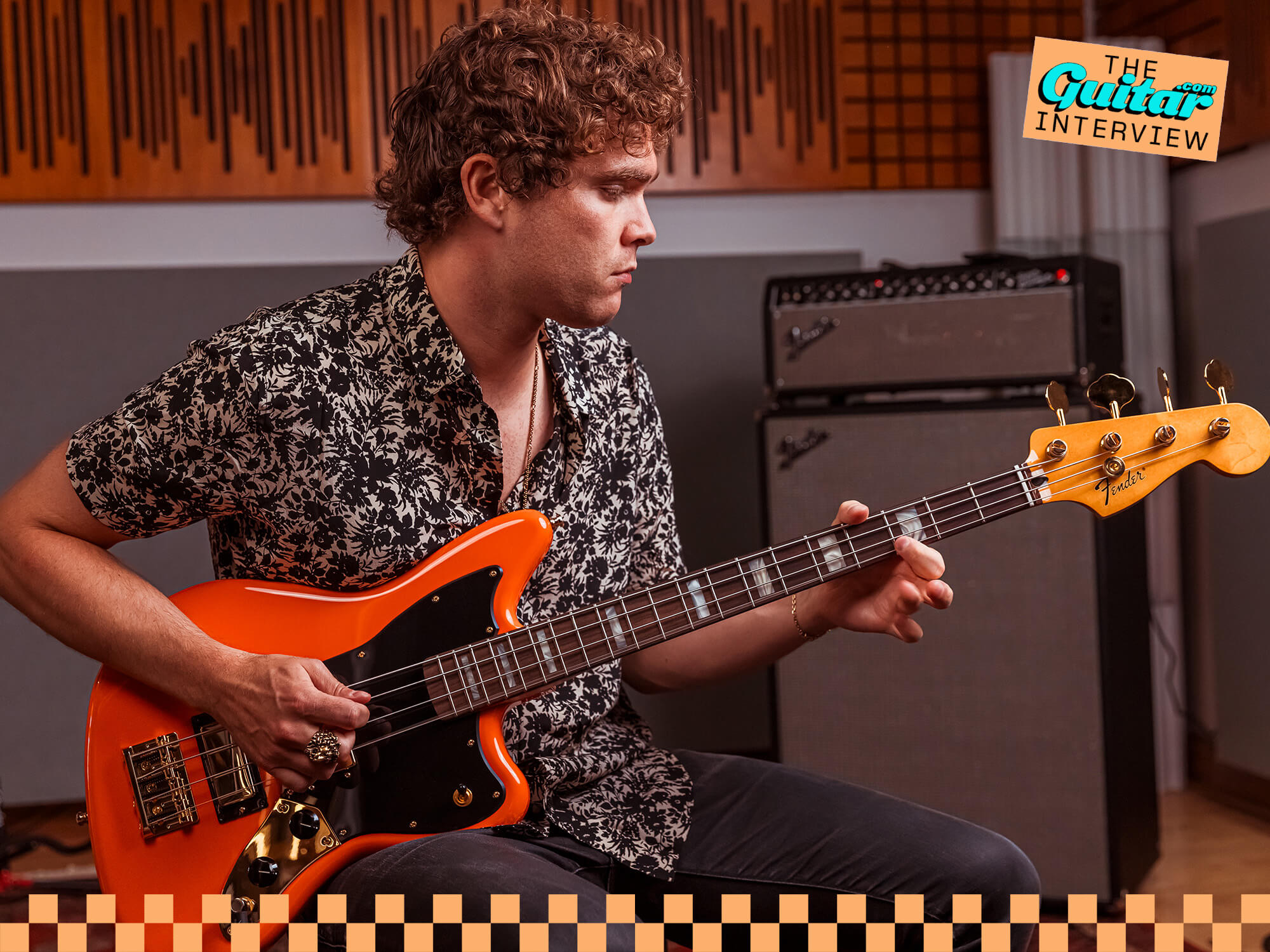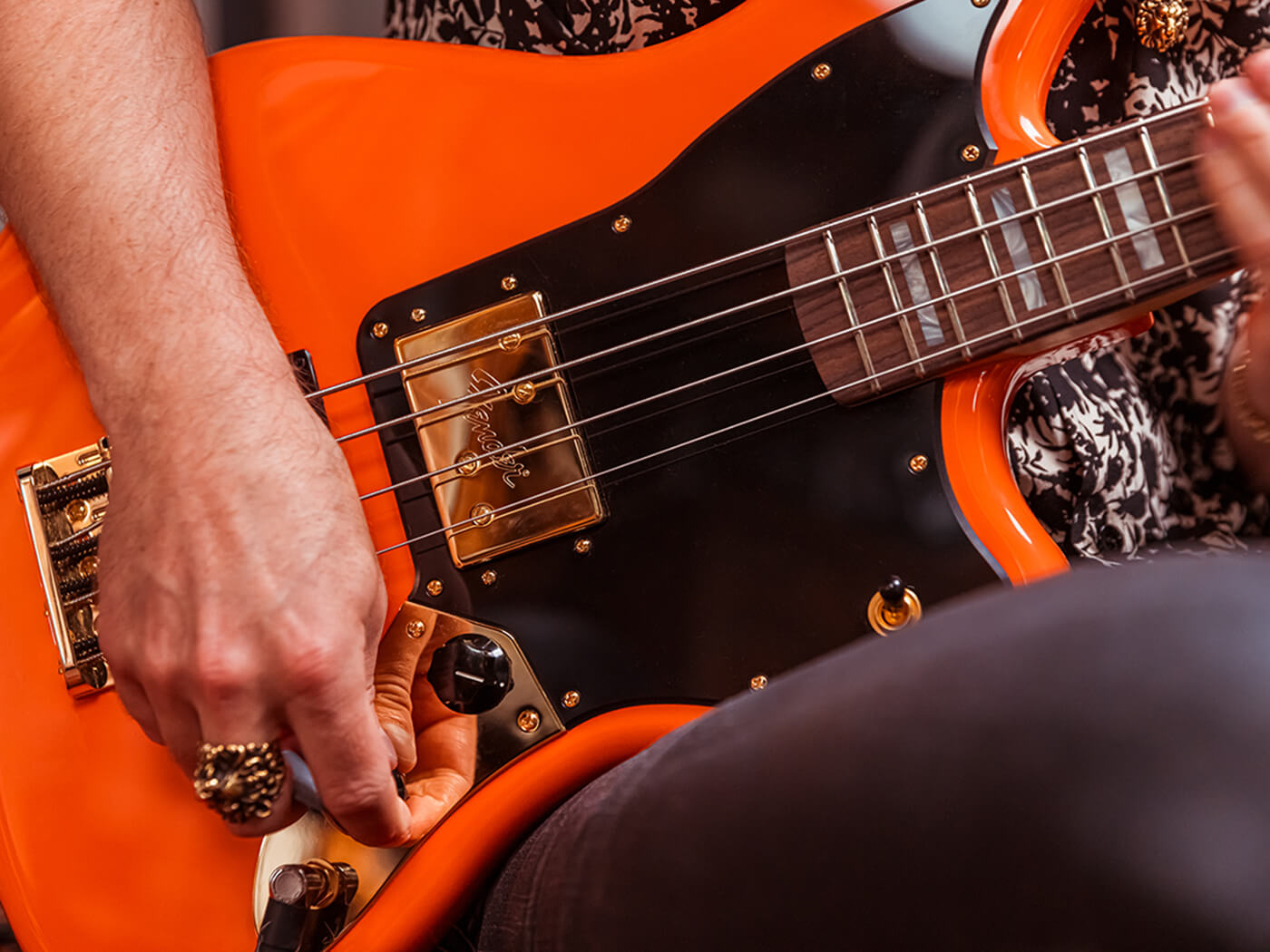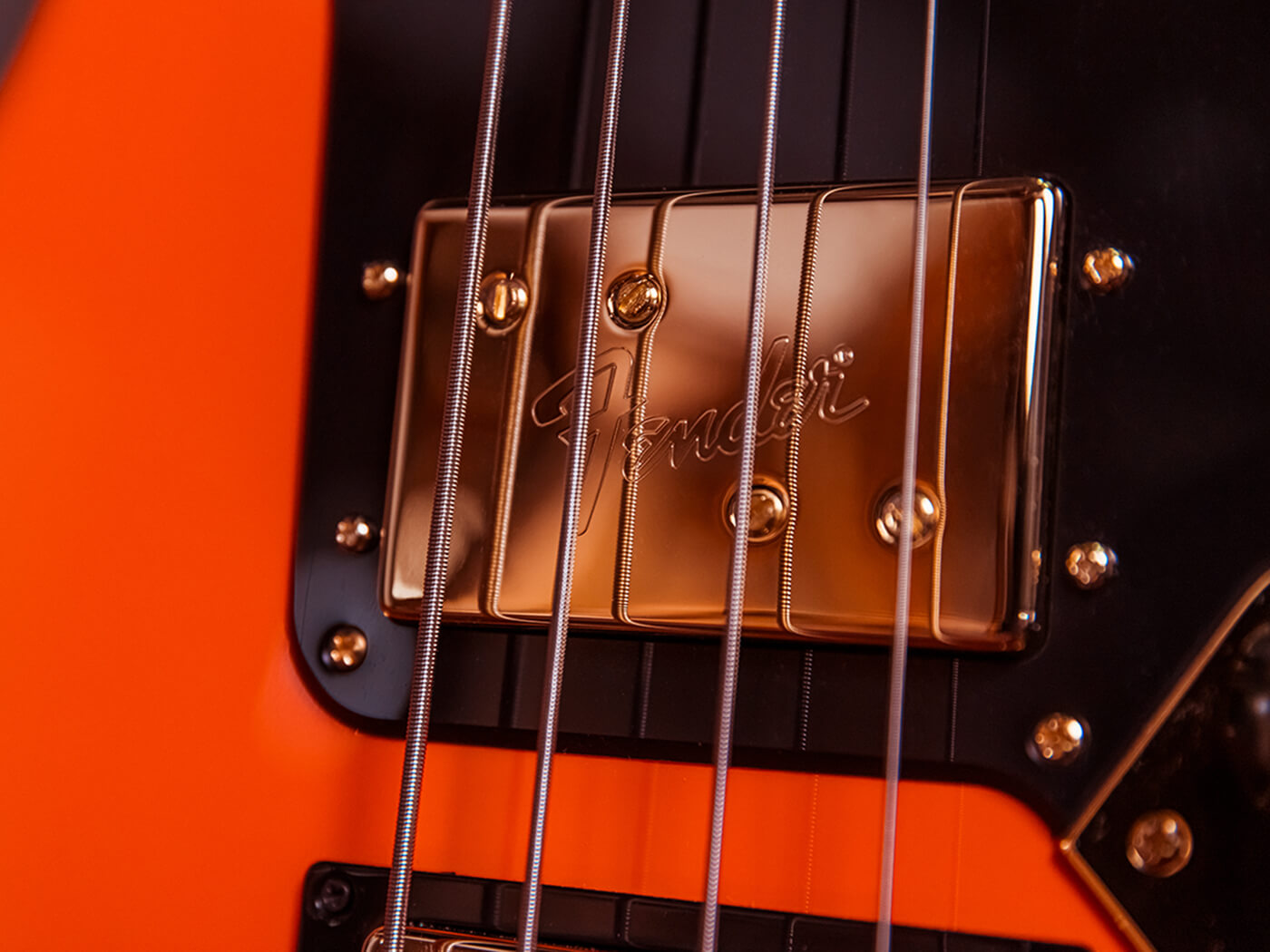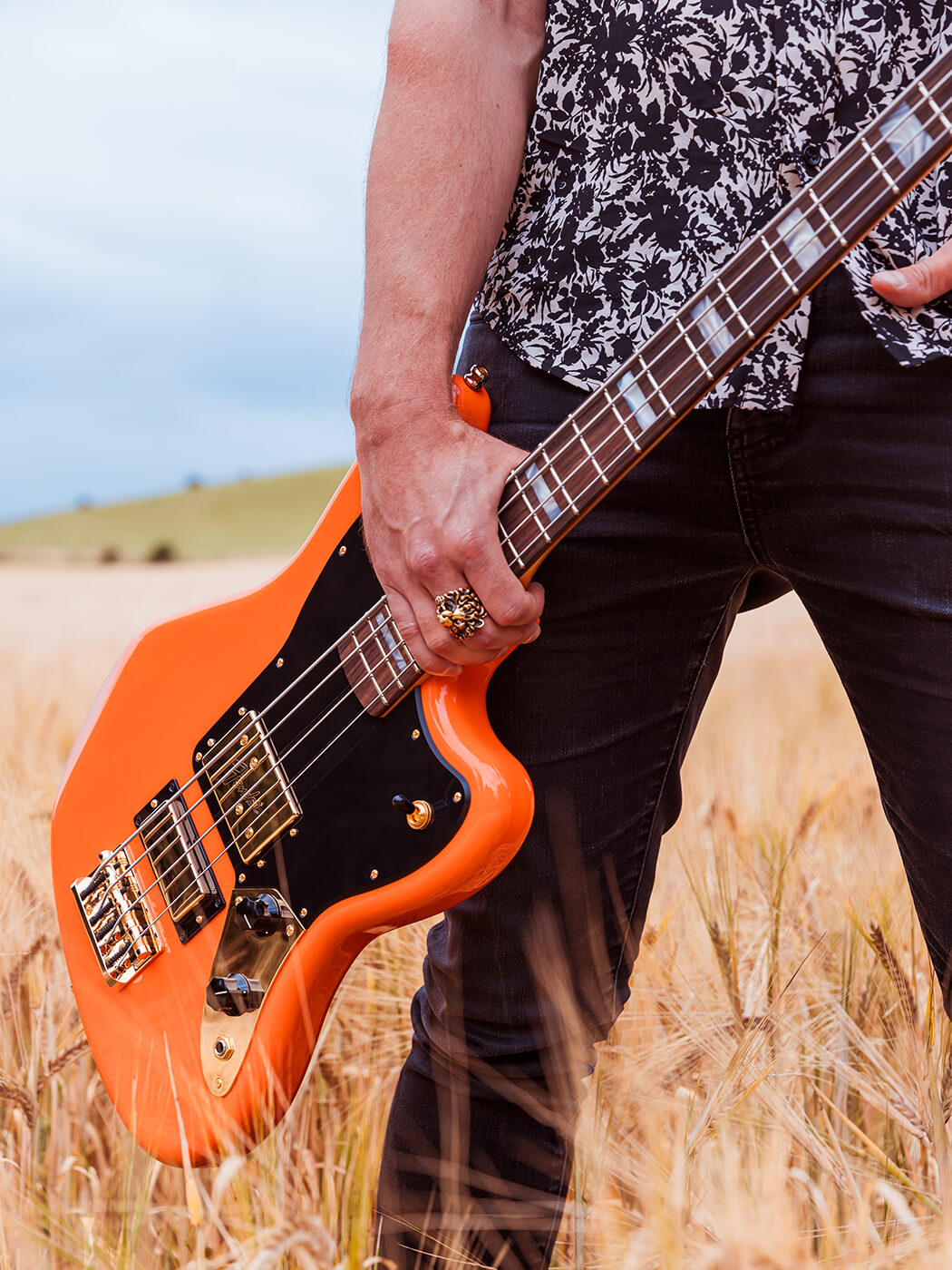Related Tags
Royal Blood’s Mike Kerr says being asked to fill in as bass player in another band is his “worst nightmare”
As the famously guarded bassist welcomes a signature model with Fender, we catch up with the Royal Blood frontman to find out how he really feels about playing bass.

Mike Kerr playing his signature Fender Jaguar bass. Image: Fender
Royal Blood’s Mike Kerr is not your average bassist. He’s not exactly a guitarist either, but has somehow helped pioneer an innovative bass revolution, despite only picking up the instrument 12 years ago, at the age of 21.
“I don’t wake up thinking ‘I am a bassist’,” he boldly admits.
For Kerr, the process to becoming the dynamic bassist he is today was a result of his aim to create “three dimensional sounds” as he calls it. Whether that’s the keyboard, the trombone or the guitar, Kerr asserts that he cares more about the sound, than what he has to do to make it. “I am still approaching it as a songwriter and what the song needs and would be the coolest part,” he explains.
There was certainly a shift in his mindset when he first picked up the bass however, as it resulted in a revelation: “Ben [Thatcher] was doing a session gig and they needed a bass player for a couple weeks and I gave it a go. It wasn’t until I then just plugged the bass into my board that I found it more exciting”.
“A few things were permeating such as the similarities between things like Rage Against The Machine and Led Zeppelin where some of the most mighty moments musically were the bass.”
“I had a eureka moment where I thought, ‘Hang on a minute, this is the place to start’,” he continues. “The bottom end of a bass was always overlooked, where guitarists would just try to emulate it with an octave pedal, but it would never hit me in the gut the same way. I just realised that if I did it the other way round I could be on to something.”

Growing pains
On to something he certainly was, as he realised something many musicians fail to do, which is to understand the importance that the bass has in a band. However, like many young instrumentalists before him, there was a long journey for him to get to that point.
“When I first started playing the bass I felt so out of my depth. The success of the band had just taken off, and it was so unexpected that I felt like I was in the deep end very quickly. Although we made an accomplished sounding record, I was still in development as a bassist.
“I felt like I was going through growing pains in public!” he exclaims. “I got dramatically better the more I got used to it, however there’s still huge gaps to my knowledge of playing bass,” Kerr admits. “My worst nightmare is a bass player dropping out of a band and asking me to step up and fill in – I would fall on my face.
“I’ve got really good at playing the bass in the context of Royal Blood but outside of that I’m not sure how I’d survive.”

Asking the bassist what has allowed him to find his “groove” with the instrument – the answer is clear: the Fender Jaguar bass he was gifted by the manufacturer six years ago.
“From the moment I was handed it, it just took time for it to become a part of our records and part of the live show and now it is the staple bass that I use. I use it to write and record everything on and it’s the bass I use for 70 per cent of the show now. Over those six seven years it’s become this important relic in the band, and it’s obvious that it should be a signature bass, and that should be the thing that people get to use.”
The road for the bass to become a signature was a rather long one for Kerr, who admits that they started talking about it when he was first gifted the bass in 2017. “It’s been something that’s only really been talked about. The fact that it’s only coming into reality now, is surreal to be honest.”
The Mike Kerr Jaguar bass offers all the features of a standard Fender Jaguar bass, such as the alder body, with a maple neck and rosewood fingerboard, with tweaks to suit Kerr’s playing style, such as a 30” scale neck and C shaped slim neck. With the addition of high-output humbuckers, the bass has been designed to help suit his “aggressive and “anthemic” playing style – according to Fender.
With gold hardware, block inlays and a Tiger’s Blood Orange finish it is certainly an eye-catching bass; something that can sit at the front of a band rather than blurring into the background.
“I always see instruments as tools really. For me it was just about what’s going to work and do the job and when I was first handed the bass the job was very clear,” Kerr says of his new signature. “It was so easy and so solid and fun to play that it became an inspiring thing to have.”

Guitarists are the blueprint
When you ask a bassist what musicians they look up to, you might expect Flea, Jaco Pastrorious maybe, or even John Paul Jones. For Kerr it is perhaps unsurprising that he’s drawn to the more melodic charms of Jimmy Page and Jack White.
“I think it’s made me reach for those frequencies and much more syncopated rhythmically,” Kerr explains. “I found that if I took the role of a bass player, I found myself a lot more on the beat and locked into the drums whereas when I repelled every rhythm and stepped away from what the drums were doing, it gave it more size.”
“Being in a two-piece is fun,” he continues. “Being able to step between being really syncopated and really on the beat. Having those gears is interesting and fun, but again although I would relate my playing to a guitarist, I still would never call myself a guitarist.”
The size of sound is evidently important for a two piece, as it is needed to fill the “space” – as Kerr describes it – when there are only two people creating the sound normally created by four or five.

“The fact that the bass is always at the forefront of the sound has got a lot to do with having fewer members, because there’s more space so the parts are written for that purpose,” he explains.
“There are some songs maybe even on this record where I take a back seat, and yes it’s still at the forefront but it’s allowing space for other things. In the earlier albums there was all the room in the world so I thought I might as well write the most rhythmically and melodically full part I can and then push sonically to the widest and tallest I can. When you have the room it’s easier.”
As a result, it’s unsurprising that Kerr has to think like a multi-instrumentalist, or a guitarist at least, when writing parts for Royal Blood. Instead of just thinking about the rhythm section, he needs to ensure that the bass is as “wide” as possible and can do everything and anything.
Therefore, Kerr clearly sees being inspired by guitarists as a strength to his writing and playing style.

“I feel like my style was propped up by who I loved, and it’s obvious in the first record where you can hear specific players and bands.
“However, it’s all those in between things that are more individual to you where over time you reach for the volume knob of the things that make you unique and turn them up as time goes on.
“That’s how you really develop your own style. Leaning into the things that make you you.”
The future is the tuner pedal
What actually allows Mike Kerr to hit those high notes and achieve the iconic tone of Royal Blood? “A tuner pedal”, he exclaims with a slight laugh. “People always thought I was taking the piss, but it’s true and it’s what has led me to where I am now.”
But how does a tuner pedal create this sound? As Kerr explains, it acts as a split pedal, allowing him to move from one amp and effect to another, as by turning on the pedal, you cut off a signal chain.
Of course like any guitarist or bassist, there is a string of pedals that help create a distinct sound, something he’s notoriously been very secretive about. While finally revealing in 2021 that his secret weapon is a Tech 21 Red Ripper, it’s the tuner pedal that really does the heavy lifting.
“There was something funny where everyone would wonder what pedal I was turning on, but really I was turning off an amp,” he continues. “That trick still gets people now “when you drop into the verse of Boilermaker what is the pedal you hit?” and what’s funny is that I’m not turning anything on, I’m turning off loads of amps, and revealing something that was there the whole time.
“It’s that illusion that I find so interesting. People see your foot go down and hit something and they assume something is being turned on, but it’s the reverse and it’s fun.”
Find out more about the Fender Mike Kerr Jaguar bass at fender.com
